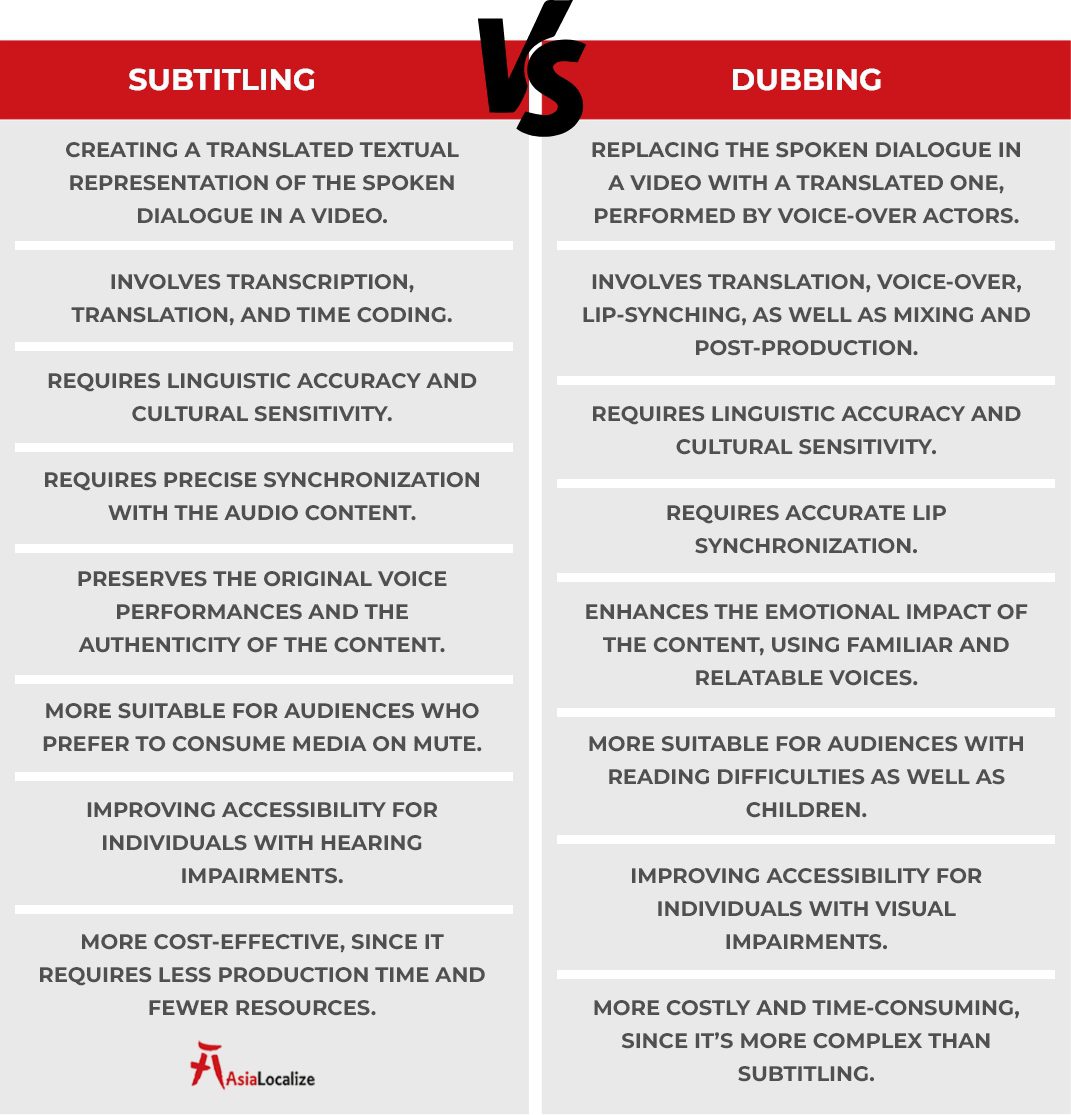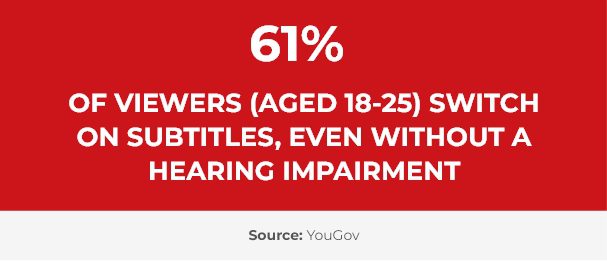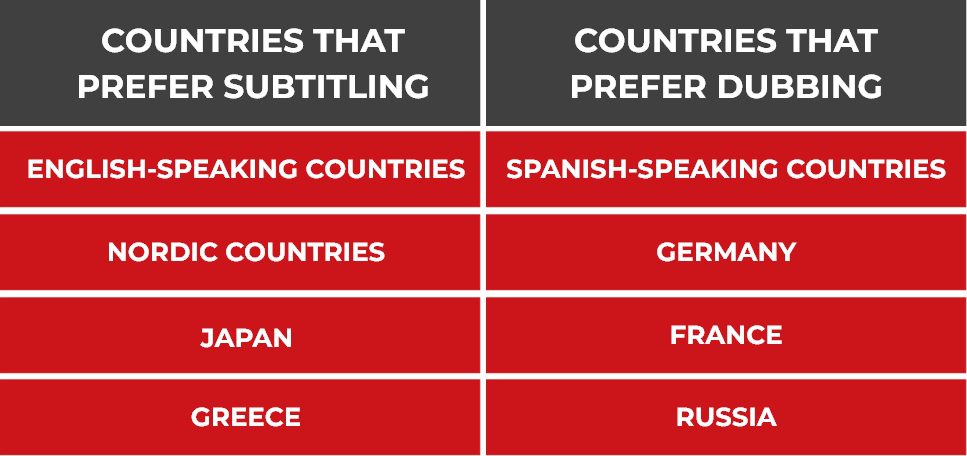
When you create a video to market your product, a TV show, or a movie, we are sure that you put your target audience’s experience at the top of your list.
This involves working hard to ensure all aspects of the video, from script creation to the selection of voice actors and the application of high-quality visuals and sound, reflect the audience’s needs and preferences.
However, while your production might resonate with your home country, it might not work well for a different target market. That’s because linguistic and cultural differences vary significantly between regions, which mandates a thorough understanding of your target audience to adapt your content to their preferences.
That’s where professional dubbing and subtitling services take part!
So, what is the difference between subtitling and dubbing? And how do you know the best method to reach your audience successfully? What may be optimal for you may not necessarily be ideal for your target audience. That’s why we have compiled all the relevant information here to help you make the right call.
What is the Difference Between Subtitling and Dubbing?
With almost thousands of films produced each year and 3.7 million videos uploaded daily on YouTube, subtitling and dubbing have become essential for all production companies and businesses of all industries striving for virality around the globe.
Both subtitling and dubbing serve the same purpose, giving your content multilingual accessibility to be understood by people who don’t speak its original language. Both empower businesses global reach and international expansion. However, each is a distinct method with its unique characteristics and applications.
What Is Subtitling?
Subtitling is a specialized type of audiovisual translation that converts the spoken dialogue and sounds in a video into translated text, known as subtitles. They are displayed on the screen, usually at the bottom of the screen, and timed to match the audio content.Â
Subtitling is used in various forms of media, including:
- Film and TV productions
- eLearning and Training Materials
- Explainer Videos and Tutorials
- Social Media and Marketing Videos/Reels
- Corporate Presentations, and more.
2 Key Considerations in Subtitling
1. Reading Speed and Character Limitations
Subtitles must be timed perfectly to match the on-screen dialogue while being concise enough to fit within the limited space.
For example, in English, it is recommended to keep subtitles within 170 words per minute, or ideally 140 words per minute (equivalent to about 3 words per second). Subtitles should typically consist of a maximum of 2 lines, each containing around 32-42 characters.
It’s essential to strike a balance between reading speed and character limitations to avoid overlapping text or rushing viewers while watching.
2. Cultural Sensitivity
It’s also crucial to consider the cultural nuances and references.
For instance, idioms and slang phrases could be confusing or even offensive if not adequately interpreted and contextualized. Language professionals should convey the meaning and essence of the original dialogue while maintaining cultural relevance in the translated text to suit the target audience’s sensibilities.
What Is Dubbing?
On the other hand, dubbing is a post-production step that replaces the original sound with another, translated and adapted to a new audience.
Dubbing is used in various forms of media, including:
- Movies and TV Shows
- Video Games
- Documentary Films
- Educational Videos
- Animations and Cartoons, and more.
2 Key Considerations in Dubbing:
1. Time Constraints
To provide a seamless, natural viewing experience to the audience, dubbing follows meticulous timing.
Professional voice artists perform the translated dialogue to fit the constraints of the video’s timing and match the length of the original dialogue while conveying the same meaning and emotions.
On the other hand, they should ensure precise synchronization with the lip movements of the on-screen characters. Otherwise, it affects the quality of the dubbing and might detract from the audience’s immersion.
2. Voice-over Capabilities
Dubbing requires outstanding voice-over and acting skills to deliver a matching performance to the original version.
It’s more than just delivering an accurate translation of the speech in your video. It hinges on their acting talent to immerse themselves and use their voices to match the style, tone, and mood to deliver your message accurately and convincingly.
The Difference Between Subtitling and Dubbing



Pros and Cons of Subtitling and Dubbing
After you’ve got an idea of the difference between subtitling and dubbing, it’s time to delve more into the world of each, discovering their respective benefits and disadvantages.
Pros of Subtitling
- Since you can listen to the original voice performances, subtitles maintain the intended visual experience of the content.
- With 5% of the global population (nearly 1.5 billion people) having disabled hearing loss, subtitling is ideal for the dead and hard-of-hearing community.
YouGov study revealed that 61% of viewers between the age of 18 and 25 said that they use subtitles – even if they do not have a hearing impairment.



There’s even a new Tiktok trend where users joke about subtitles being a crucial part of their viewing pattern, claiming that they can’t hear without the subtitles one’s.
- Subtitling doesn’t only empower your global digital presence through user engagement, it enhances your videos SEO and increases traffic to your website or platform.
- According to the European Audiovisual Observatory, subtitling is more affordable than video dubbing, actually ten times cheaper than, video dubbing.
With less production time, subtitling allows your media content to be released for your audiences in multiple languages faster.
Cons of Subtitling
- It may require the viewer to remain attentive for a prolonged period, potentially leading to distractions from the main action.
- Sometimes, it can be overwhelming for viewers who are not acquainted with the spoken language.
- Subtitling has time and space constraints that require exceptional language and technical capabilities to skillfully manage.
- Subtitles don’t need to be synced with the lip movements. However, subtitle synchronization is crucial, especially since it can affect your viewer’s total experience.
- Sometimes, it is not suitable for all ages, particularly children.
Dubbing Advantages
- Dubbing delivers a more immersive viewing experience since you don’t have to read or pay attention to anything except the action and beauty of the visuals. Nothing blocks your way; nothing distracts you from the action.
- It makes your content more accessible to audiences who have reading difficulties as well as younger audiences.
- Dubbing can make your content more personalized by leveraging voice-over that incorporates different regional dialects.Â
Dubbing Disadvantages
- It can go really wrong if it is done unprofessionally. This requires
- Professional voice-over artists who sound similar to the original voices and infuse authenticity into your content.
- Exceptional audio and mixing quality to deliver a dubbed version that matches the quality of the original content.
- Some people think dubbing hinders their ability to enjoy and appreciate the original performance.
- The dubbed version must synchronize with lip movements; otherwise, it may disconnect and disappoint your target audience.
With more production time and multidisciplinary resources, dubbing can be quite expensive and time-consuming.
How Does a Project Get Dubbed or Subtitled?
Dubbing and subtitling involve much more than simply translating from one language to another. Instead, it’s about localizing your content, considering both the linguistic and cultural nuances, to provide an engaging viewing experience.
Putting your project in professional hands is crucial to ensuring successful localization. So, we are not overstating if we say that picking the right language vendor is your first step toward high-quality dubbing and subtitling, as well as achieving global success and avoiding costly mistakes.
And to help you in your endeavor, we have dedicated this section to giving you a sneak peek into what goes on backstage.
Dubbing and subtitling can be quite complex, but we’ll do our best to simplify them for you. So, are you ready to dive in?
Subtitling Process
- Transcription: Here, professionals will convert the dialogue into a written script, which will serve as the basis for the entire project.
- Translation: At this stage, the team will translate the given script from the original language to the target language, keeping in mind the character limit (based on the target language).
- Timecoding: This is where the subtitle translation company adds precise time codes to be able to place the subtitles at the correct times and be in sync with the audio.
- QA and Proofreading: Then, the subtitles go through robust QA checks. A different team of professionals identifies and resolves any issues related to linguistic accuracy, cultural relevance, and audio synchronization.
- Simulation: The final version is then put through a simulation session to identify and fix any issues related to timing or text.
Dubbing Process
- Transcription and Timecoding: As subtitling, a team of experts converts the spoken dialogue into a written script and adds time codes to facilitate the translation and recording steps.
- Translation: A team of native experts in your source and target languages will localize your content and adapt it to your audience, keeping cultural nuances in mind.
- Voice-over: A whole team of native-speaking voice actors, linguists, voice coaches, and a director work hand in hand to portray the original characters.
- Lip Synchronization: Audio and video technicians adjust the timing and pacing of the dubbed audio, matching lip movements with the original audio.
- Mixing: At this stage, sound editors bring everything together, adding the dubbed version instead of the original one, while ensuring a seamless blend of all audio elements.
Subtitling vs. Dubbing: What is Best For Your Business?
Knowing the difference between subtitling and dubbing is not enough to make the right choice for your business. It’s essential to consider many factors before making a choice.
- Target Market: When deciding between subtitling and dubbing, it is essential to consider legal and cultural constraints that vary across different markets. For instance, some countries require all audiovisual materials to be dubbed or subtitled. In the US, the Americans with Disabilities Act demanded that any video meant for the public should include closed captions or transcripts for all individuals with hearing impairments.






Subtitling vs. Dubbing: Which is Better for a More Immersive Viewing Experience?
If you’re short on time, this guide can be handy.
- Budget: This factor can have a decisive influence on your choice. Dubbing is 15 times more costly than subtitling. So, if you have a limited budget, you may need to choose subtitling as a cost-effective option.
- Content Type: Working on a documentary or a TV show is different from working on a marketing video. Marketing videos, on the other hand, are often better suited for subtitling than dubbing.
- Your Audience Age (if already decided): Dubbing might be the ideal option if your target audience is children. Besides their lack of ability to read subtitles, they love to hear their favorite character speak their language and culture.
Now that you’ve learned the difference between subtitling and dubbing and got a glimpse into their processes, do you think you are ready for the giant leap?
At this time, it’s better to get some help from a professional multimedia translation company to get all that you need under one roof, from reliable resources to the best technologies and processes. AsiaLocalize can do that and more for you.
So why choose our multimedia localization services? Based in the heart of Asia, we are a professional translation company well-versed in diverse Asian languages and cultures. Plus, our team of highly skilled linguists, coupled with innovative technologies, is fully dedicated to ensuring a seamless and comprehensive subtitling experience for your target market.



Want to Discuss your Multimedia Translation Project with Our Experts?
